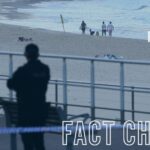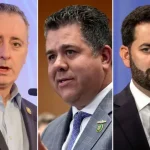
Authored by Techno Fog via The Reactionary,
Henry Kissinger is dead at 100.
He rose to power from humble beginnings. His middle-class Jewish family escaped Germany for the United States in 1938. After graduating high school and attending one year of college (studying accounting, of all things), Kissinger would enlist in the Army and serve in Germany until 1947.
Upon his return to the States, and through the advice of a mentor, he would gain admission to Harvard, where he excelled as an undergraduate and graduate student. His academic career at Harvard, starting in 1951, was also the beginning of his professional trajectory. Kissinger would establish himself as an important foreign policy theorist and a “recognized expert on the role of nuclear weapons in American foreign policy.” At the same time, by way of his position at Harvard, he would forge relationships with prominent American and foreign political figures. Kissinger’s network, and really his scope of influence, would further grow after his 1955 appointment to the Council of Foreign Relations, where he was brought in contact with “many of the most powerful men in the nation” including the Rockefellers.
Through the later 1950s and into the 1960s, Kissinger would cement himself as a best-selling author (Nuclear Weapons and Foreign Policy in 1957) and prolific writer. For all the talk of Kissinger’s genius (then and now), many of his ideas at that time were unoriginal, illogical, and near-delusional. For example, in Nuclear Weapons and Foreign Policy, Kissinger argued in favor of limited nuclear war (as opposed to all-out nuclear war). To avoid the escalation from limited nuclear war to all-out nuclear war – a very real and obvious danger – Kissinger proposed conditions by which such a war could take place, such as using “diplomacy to convey to our opponent what we understand by limited nuclear war, or at least what limitations we are willing to observe.” He argued that “a war which began as a limited nuclear war would have the advantage that its limitations could have been established” in advance of hostilities. These ideas were as ludicrous then as they are now, and were criticized as such after publication. As one writer more recently observed, “Kissinger’s limited nuclear war had to be conceived and waged as an Ivy League fencing match.”
Kissinger would eventually obtain a tenured professorship at Harvard in 1962. Yet he was not destined for academia; his appetite was for high-stakes policymaking. He was the foreign policy advisor for Nelson Rockefeller’s failed presidential campaigns and in 1968, when Nixon won the Republican nomination, Kissinger made it clear that he wanted to be part of the potential Nixon Administration. (Kissinger was adept enough to leave open the possibility of a position in the Humphrey administration, had he defeated Nixon.)
The lengths Kissinger might go to assist then-candidate Nixon – and thus ensure Kissinger’s ascent – were revealed in 1968, as President Lyndon B. Johnson sought to begin peace negotiations and bring about an end to the Vietnam War. This would undoubtedly benefit Democrat candidate Vice President Hubert Humphrey. Nixon learned of that peace effort via leaks from Kissinger, who was serving as an advisor to President Johnson and attended the Paris Peace talks with the North Vietnamese. Nixon then instructed his closest advisor, H.R. Haldeman, to “monkey wrench” the negotiations. The South Vietnamese were pressured to “hold firm” by Nixon’s allies. With the understanding that Nixon could deliver better terms, the South Vietnamese boycotted the talks. Nixon would win the election. Over 25,000 more Americans would die in Vietnam before the war eventually concluded.
Kissinger’s duplicity was rewarded with his appointment of National Security Advisor after Nixon took office in 1969. Seizing on Nixon’s distrust of the State Department, Kissinger executed a “quiet coup” to exclude other agencies and officials from the foreign policy decision-making process (an idea Nixon liked), effectively guaranteeing his “position as the foreign policy czar.”
This structure allowed for streamlined decisions, Executive control, a reduction in bureaucratic meddling, and secrecy. Beginning in the Spring of 1969 through 1973, the Nixon and Kissinger conducted a secret and illegal and extensive bombing operation (codenamed MENU) of purported North Vietnamese routes and alleged headquarters in Cambodia. The architect and overseer of this plan was Kissinger. In fact, Kissinger maneuvered to ensure Nixon’s approval of the plan after the Secretary of State objected.
In the first 14 months of the operation (codenamed MENU), there would be a total of 3,630 flights dropping 110,000 tons of bombs. In total, U.S. planes “dropped 500,000 or more tons of munitions.” Gunships would rake children. The Nixon Administration and Kissinger conspired to keep the carpet bombings secret while Kissinger oversaw its execution and “approved each of the 3,875 Cambodia bombing raids” with “full knowledge of it effect on civilians.” Kissinger’s instructions for strikes (following Nixon’s demands) weren’t to hit military targets, but “anything that moves.” Many times, innocent Cambodian villages would be “hit with dozens of payloads over the course of several hours. The result was near-total destruction.”

Interviews of Cambodian victims by The Intercept reveal the first-person horror. One woman described what she experienced as a young girl, stating “At around 10 a.m., an airplane dropped a bomb on my home. My parents and four siblings were all killed.” Thousands of others had similar stories: “I lost my mother, father, sisters, brothers, everyone.” It is estimated that as many as 150,000 civilians were killed – all at the direction of Henry Kissinger.
Subscribers to The Reactionary can read the rest here...
Authored by Techno Fog via The Reactionary,
Henry Kissinger is dead at 100.
He rose to power from humble beginnings. His middle-class Jewish family escaped Germany for the United States in 1938. After graduating high school and attending one year of college (studying accounting, of all things), Kissinger would enlist in the Army and serve in Germany until 1947.
Upon his return to the States, and through the advice of a mentor, he would gain admission to Harvard, where he excelled as an undergraduate and graduate student. His academic career at Harvard, starting in 1951, was also the beginning of his professional trajectory. Kissinger would establish himself as an important foreign policy theorist and a “recognized expert on the role of nuclear weapons in American foreign policy.” At the same time, by way of his position at Harvard, he would forge relationships with prominent American and foreign political figures. Kissinger’s network, and really his scope of influence, would further grow after his 1955 appointment to the Council of Foreign Relations, where he was brought in contact with “many of the most powerful men in the nation” including the Rockefellers.
Through the later 1950s and into the 1960s, Kissinger would cement himself as a best-selling author (Nuclear Weapons and Foreign Policy in 1957) and prolific writer. For all the talk of Kissinger’s genius (then and now), many of his ideas at that time were unoriginal, illogical, and near-delusional. For example, in Nuclear Weapons and Foreign Policy, Kissinger argued in favor of limited nuclear war (as opposed to all-out nuclear war). To avoid the escalation from limited nuclear war to all-out nuclear war – a very real and obvious danger – Kissinger proposed conditions by which such a war could take place, such as using “diplomacy to convey to our opponent what we understand by limited nuclear war, or at least what limitations we are willing to observe.” He argued that “a war which began as a limited nuclear war would have the advantage that its limitations could have been established” in advance of hostilities. These ideas were as ludicrous then as they are now, and were criticized as such after publication. As one writer more recently observed, “Kissinger’s limited nuclear war had to be conceived and waged as an Ivy League fencing match.”
Kissinger would eventually obtain a tenured professorship at Harvard in 1962. Yet he was not destined for academia; his appetite was for high-stakes policymaking. He was the foreign policy advisor for Nelson Rockefeller’s failed presidential campaigns and in 1968, when Nixon won the Republican nomination, Kissinger made it clear that he wanted to be part of the potential Nixon Administration. (Kissinger was adept enough to leave open the possibility of a position in the Humphrey administration, had he defeated Nixon.)
The lengths Kissinger might go to assist then-candidate Nixon – and thus ensure Kissinger’s ascent – were revealed in 1968, as President Lyndon B. Johnson sought to begin peace negotiations and bring about an end to the Vietnam War. This would undoubtedly benefit Democrat candidate Vice President Hubert Humphrey. Nixon learned of that peace effort via leaks from Kissinger, who was serving as an advisor to President Johnson and attended the Paris Peace talks with the North Vietnamese. Nixon then instructed his closest advisor, H.R. Haldeman, to “monkey wrench” the negotiations. The South Vietnamese were pressured to “hold firm” by Nixon’s allies. With the understanding that Nixon could deliver better terms, the South Vietnamese boycotted the talks. Nixon would win the election. Over 25,000 more Americans would die in Vietnam before the war eventually concluded.
Kissinger’s duplicity was rewarded with his appointment of National Security Advisor after Nixon took office in 1969. Seizing on Nixon’s distrust of the State Department, Kissinger executed a “quiet coup” to exclude other agencies and officials from the foreign policy decision-making process (an idea Nixon liked), effectively guaranteeing his “position as the foreign policy czar.”
This structure allowed for streamlined decisions, Executive control, a reduction in bureaucratic meddling, and secrecy. Beginning in the Spring of 1969 through 1973, the Nixon and Kissinger conducted a secret and illegal and extensive bombing operation (codenamed MENU) of purported North Vietnamese routes and alleged headquarters in Cambodia. The architect and overseer of this plan was Kissinger. In fact, Kissinger maneuvered to ensure Nixon’s approval of the plan after the Secretary of State objected.
In the first 14 months of the operation (codenamed MENU), there would be a total of 3,630 flights dropping 110,000 tons of bombs. In total, U.S. planes “dropped 500,000 or more tons of munitions.” Gunships would rake children. The Nixon Administration and Kissinger conspired to keep the carpet bombings secret while Kissinger oversaw its execution and “approved each of the 3,875 Cambodia bombing raids” with “full knowledge of it effect on civilians.” Kissinger’s instructions for strikes (following Nixon’s demands) weren’t to hit military targets, but “anything that moves.” Many times, innocent Cambodian villages would be “hit with dozens of payloads over the course of several hours. The result was near-total destruction.”

Interviews of Cambodian victims by The Intercept reveal the first-person horror. One woman described what she experienced as a young girl, stating “At around 10 a.m., an airplane dropped a bomb on my home. My parents and four siblings were all killed.” Thousands of others had similar stories: “I lost my mother, father, sisters, brothers, everyone.” It is estimated that as many as 150,000 civilians were killed – all at the direction of Henry Kissinger.
Subscribers to The Reactionary can read the rest here…
Loading…





